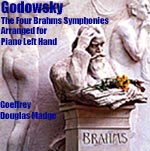As the saying goes, truth is stranger than fiction, particularly so in the case of Leopold Godowsky’s piano versions of Brahms’ Four Symphonies for the left hand alone. Following his triumphant Berlin debut in 1900 where he played the Tchaikovsky First and Brahms Second Concertos in a single evening, Godowsky returned to his hotel and sketched a piano arrangement for the opening movement of Brahms’ First Symphony. As legend has it, by dawn he had completed rough drafts not only of the entire First Symphony, but Brahms’ Second as well. Godowsky initially utilized a single staff to save space, yet quickly discovered how well Brahms’ orchestral textures and polyphonic rigor lent themselves to single-handed treatment. The next day, en route by train from Berlin to Amsterdam, he sketched piano left-hand versions for Brahms’ Third and Fourth Symphonies. Hours after arriving in Amsterdam, however, Godowsky realized that he had left his manuscripts behind.
As it turned out, an astute passenger found the music, and passed it on to an acquaintance in the library of the Royal Conservatory at The Hague. The scores were filed away, forgotten, for nearly a century. They materialized during the library’s 1998 renovation, when faculty member, noted pianist, and Godowsky authority Geoffrey Douglas Madge stumbled upon them. For the next two years, Madge diligently fashioned these sketches into viable performing versions, fortified by his intimate knowledge of Godowsky’s transcriptions, work habits, and notational idiosyncrasies.
As we readily hear, the first two Brahms symphonies are reproduced virtually note-for-note, whereas the Third and Fourth provide springboards for all manners of Godowskian emendations. Note, for example, the slithering chromatic runs engulfing the F major symphony’s touching third movement theme, or the blatant, Gershwinesque harmonizations at the finale’s outset. Godowsky expands the Fourth Symphony’s jaunty scherzo with a fugal fantasy and obligatory cadenza. The Passacaglia Finale is showered with dazzling filigree that teeters between naughty and nice. Most bizarre, though, is the nearly 20-minute free-form fantasia that Godowsky concocted to preface the Fourth Symphony. Thankfully it bears its own index so that listeners can cut to the chase, so to speak, if they choose.
Understandably Madge adopts magisterial tempos throughout in order to accommodate Godowsky’s cruel technical demands, relentless register leaps, and frequent pedal changes. But does his measured tread truly reflect the cumulative frisson Godowsky envisioned as he sketched these daunting works at fever pitch? True, Madge’s spacious sculpting of the First Symphony cogently mirrors the static desolation of Celibidache’s definitive Munich Philharmonic utterance. Yet we miss the radiant clangtint and fiery cool Marc-André Hamelin presumably will unleash when he records this cycle for Hyperion in 2003. Since Hamelin’s Godowsky/Chopin Studies required but two discs to Madge’s pioneering four, one assumes that the five CDs needed to encompass Madge’s Godowsky/Brahms may also slim down as a result of Hamelin’s (again, presumably) faster tempos. Altarus provides an anecdotal yet detailed account of the recording sessions by Bryce Morrison, but offers frustratingly little about the music itself. Goodish engineering, although the 98-key Rialto Imperial Grand’s supplementary bass notes do not quite hold their tuning.
































